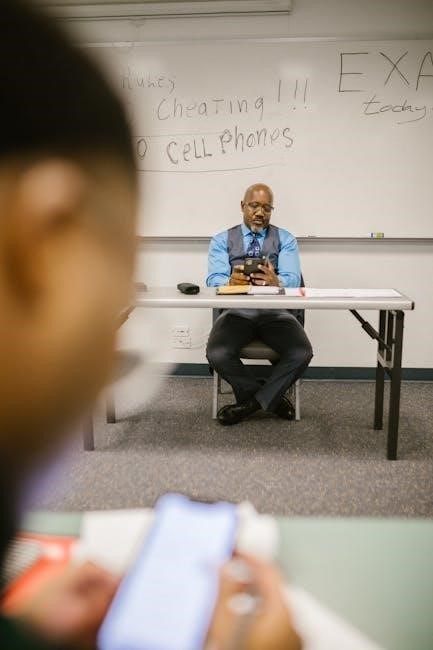nclb test study guide

nclb test study guide
The No Child Left Behind Act (NCLB), signed into law by President George W. Bush in 2002, reauthorized the Elementary and Secondary Education Act (ESEA) of 1965. It aimed to improve public education by setting high academic standards, emphasizing accountability, and requiring annual testing in reading and mathematics for students in grades 3 through 8 and once in high school. The law focused on narrowing achievement gaps, particularly for low-income and minority students, before being replaced by the Every Student Succeeds Act (ESSA) in 2015;

Key Provisions of NCLB
The No Child Left Behind Act (NCLB) introduced several key provisions aimed at improving education outcomes and ensuring accountability in U.S. schools. One of the most significant provisions was the requirement for states to develop and implement assessments in reading and mathematics for students in grades 3 through 8 and once in high school. These assessments were designed to measure student progress and hold schools accountable for meeting academic standards.
Another critical component of NCLB was the concept of Adequate Yearly Progress (AYP). Schools were required to meet annual benchmarks for student performance, with the ultimate goal of achieving 100% proficiency in reading and mathematics by 2014. AYP was calculated based on test scores, graduation rates, and participation rates in testing. Schools that failed to meet AYP for consecutive years faced consequences, such as offering school choice options or providing supplemental educational services like tutoring.
NCLB also emphasized the importance of teacher quality. It mandated that schools ensure all teachers were “highly qualified,” meaning they had obtained full state certification and demonstrated expertise in the subjects they taught. This provision aimed to elevate the professionalism of teaching and improve student learning outcomes.
Additionally, the law required schools to disaggregate test data by student subgroups, including racial and ethnic groups, low-income students, English language learners, and students with disabilities. This provision was intended to identify and address achievement gaps, ensuring that no subgroup was left behind in the educational process.
NCLB also placed a strong focus on accountability and transparency. Schools were required to report test results and progress publicly, providing parents and communities with clear information about school performance. This transparency was designed to engage stakeholders in efforts to improve education.
Finally, the law included provisions for federal funding and support for schools, particularly those serving low-income students. It allocated resources for professional development, tutoring, and other programs aimed at raising academic achievement.
Overall, NCLB’s provisions were designed to create a framework for accountability, improve teaching quality, and ensure that all students, regardless of background, had access to a high-quality education.
Criticisms and Controversies
The No Child Left Behind Act (NCLB) faced significant criticism and controversy during its implementation. One of the primary concerns was the law’s heavy reliance on standardized testing, which critics argued led to a narrow curriculum and “teaching to the test.” Schools often focused disproportionately on math and reading, potentially neglecting other important subjects like science, history, and the arts. This created a culture where test preparation took precedence over broader educational goals.
Another major criticism was the law’s one-size-fits-all approach to accountability. Critics argued that the Adequate Yearly Progress (AYP) metric was overly simplistic and failed to account for the diversity of student populations and school contexts. For example, schools serving low-income or minority students often faced greater challenges in meeting AYP, leading to accusations that the law unfairly penalized these institutions.
The emphasis on testing also raised concerns about its impact on student learning. Educators and researchers pointed out that high-stakes testing could lead to unnecessary stress for students and teachers alike. Additionally, some critics argued that the law’s focus on test scores ignored the importance of critical thinking, creativity, and other valuable skills that are not easily measured by standardized tests.
Critics also highlighted the law’s unintended consequences, such as schools manipulating test results or excluding certain student groups from testing to improve their AYP standings. This practice, often referred to as “gaming the system,” undermined the law’s intended goal of ensuring accountability and improving education for all students.
Furthermore, NCLB was criticized for its lack of flexibility and failure to address the unique needs of different student populations. For instance, English language learners and students with disabilities often faced significant barriers in meeting the law’s requirements, leading to calls for more nuanced and equitable policies.
Despite its good intentions, NCLB became a polarizing piece of legislation, with many educators, policymakers, and parents advocating for its reform or repeal. These criticisms ultimately contributed to the passage of the Every Student Succeeds Act (ESSA) in 2015, which sought to address many of the shortcomings of NCLB by granting states more flexibility in education policy.

Impact on Student Groups
The No Child Left Behind Act (NCLB) had a significant impact on various student groups, particularly those who have historically been underserved in the education system. The law aimed to narrow the achievement gap between different student populations, including racial and ethnic minorities, low-income students, students with disabilities, and English language learners. By requiring schools to report test scores for these subgroups, NCLB brought attention to the disparities in educational outcomes and pushed schools to address these inequities.
One of the key provisions of NCLB was its focus on ensuring that all students, regardless of their background, were held to the same high academic standards. This led to increased accountability for schools serving historically disadvantaged student groups. For example, schools were required to make Adequate Yearly Progress (AYP) for each subgroup, which forced educators to pay closer attention to the performance of minority and low-income students who might have been overlooked in the past.
However, critics argued that NCLB’s one-size-fits-all approach did not adequately account for the unique challenges faced by certain student groups. For instance, students with disabilities often faced difficulties meeting the law’s rigorous testing requirements, as accommodations were not always sufficient. Similarly, English language learners struggled with the emphasis on standardized tests, which were often administered in English, putting these students at a disadvantage.
Despite these challenges, some studies suggest that NCLB had a positive impact on certain student groups. For example, there was evidence of improved test scores among African American and Hispanic students in some states, indicating that the law’s focus on accountability and targeted interventions may have contributed to these gains. Additionally, NCLB’s emphasis on data-driven decision-making helped identify schools where specific student groups were underperforming, allowing for more targeted support.
Nevertheless, the law’s rigid requirements and high-stakes testing model were criticized for disproportionately affecting vulnerable student groups. Some schools responded to the pressure of meeting AYP by narrowing the curriculum or implementing test-preparation strategies that did not address the broader educational needs of their students. This led to concerns that NCLB was leaving certain groups of students further behind, despite its intent to do the opposite.

Assessment and Testing
The No Child Left Behind Act (NCLB) introduced significant changes to how student learning was assessed in U.S. public schools. A cornerstone of the law was its emphasis on standardized testing as a measure of school accountability. Under NCLB, states were required to develop and administer annual assessments in reading and mathematics for students in grades 3 through 8 and once in high school. These tests were designed to measure student progress toward meeting state academic standards.
NCLB mandated that schools report test results for all students, as well as for specific subgroups, such as racial and ethnic minorities, low-income students, students with disabilities, and English language learners. This reporting requirement ensured that schools were held accountable for the performance of every student, not just the overall student body. Schools were also required to make Adequate Yearly Progress (AYP), a measure of improvement in test scores, to avoid penalties and sanctions.
The law’s focus on testing and accountability led to a shift in educational practices. Many schools adopted test-preparation strategies, and some narrowed their curriculum to focus heavily on tested subjects, often at the expense of other areas like arts and physical education. While this approach was criticized for limiting the breadth of education, it was defended as a necessary step to ensure schools were held to high standards.
NCLB also required states to identify schools that failed to meet AYP and implement improvement plans. Schools that consistently underperformed faced escalating consequences, including restructuring or even closure. This high-stakes testing environment created significant pressure on educators and students alike, leading to debates about the validity and fairness of using test scores as the primary measure of school success.
Despite its intentions, NCLB’s testing provisions faced criticism for oversimplifying the complexities of education. Critics argued that the law’s reliance on standardized tests led to teaching to the test and did not account for the diverse needs and abilities of students. Additionally, some studies suggested that the tests were not always aligned with state standards, raising questions about their effectiveness in measuring student learning.

Outcomes and Reauthorization
The No Child Left Behind Act (NCLB) had a profound impact on U.S. education, leading to both measurable progress and significant criticism. By the time NCLB was due for reauthorization in 2007, debates over its effectiveness had already begun. While the law succeeded in raising accountability standards and narrowing achievement gaps in some areas, critics argued that its rigid requirements and overemphasis on standardized testing had unintended consequences, such as narrowing the curriculum and discouraging innovative teaching practices.
One of the most notable outcomes of NCLB was the improvement in math scores, particularly among elementary and middle school students. Studies showed statistically significant gains in mathematics performance, with some research attributing this progress to the law’s focus on accountability and annual testing. However, reading scores saw less consistent improvement, and critics argued that the law’s emphasis on test preparation limited the broader educational experience for students.
NCLB’s reauthorization was delayed for several years due to bipartisan disagreements over its implementation and effectiveness. In 2015, the Every Student Succeeds Act (ESSA) was signed into law, replacing NCLB and shifting the focus from federal mandates to state-level decision-making. ESSA maintained some of NCLB’s core principles, such as annual assessments and accountability measures, but it also provided states with greater flexibility to design their own education plans and reduce the emphasis on high-stakes testing.
ESSA addressed many of the criticisms of NCLB by allowing schools to adopt more holistic approaches to education, including measures of student success beyond test scores, such as graduation rates and access to advanced coursework. The new law also aimed to reduce the teaching-to-the-test culture that had developed under NCLB, encouraging schools to focus on a well-rounded education.